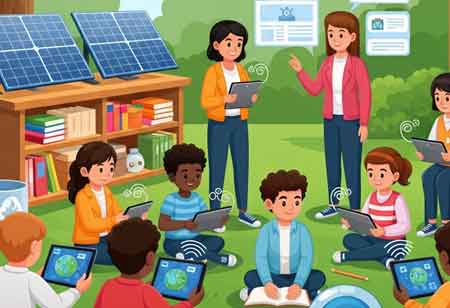THANK YOU FOR SUBSCRIBING
Be first to read the latest tech news, Industry Leader's Insights, and CIO interviews of medium and large enterprises exclusively from Education Technology Insights
The Intersection of Sustainability and Educational Technology
The education sector, traditionally reliant on physical infrastructure and paper-based materials, has a significant environmental footprint.

By
Education Technology Insights | Tuesday, August 26, 2025
Stay ahead of the industry with exclusive feature stories on the top companies, expert insights and the latest news delivered straight to your inbox. Subscribe today.
Fremont, CA: The education sector, traditionally reliant on physical infrastructure and paper-based materials, has a significant environmental footprint. However, the rapid evolution of Educational Technology (EdTech) is presenting a powerful counter-narrative, demonstrating how digital solutions can substantially reduce ecological impact and foster a more sustainable future for learning.
The Pillars of Environmental Reduction through EdTech
EdTech contributes to sustainability through several key areas, including the Paperless Revolution, Minimized Energy Consumption in Physical Infrastructure, Virtual Collaboration, and Sustainable Curriculum and Environmental Awareness. The paperless revolution reduces paper consumption through e-books and online resources, while digital assignments and submissions eliminate the need for printed materials. For instance, platforms like Google Classroom and Microsoft Teams facilitate digital assignments and submissions. EdTech also minimizes energy consumption in physical infrastructure through remote and hybrid learning, innovative smart classroom management, and the use of energy-efficient devices and data centers. Virtual collaboration and online events further reduce the need for transportation. EdTech also fosters environmental literacy and action through immersive learning, data science for ecological solutions, and citizen science projects. Digital Classroom Solutions help students develop practical problem-solving skills and become active environmental stewards.
Latest Trends and Innovations
The current EdTech landscape is rapidly evolving with innovations that enhance its sustainability potential across multiple dimensions. Artificial Intelligence (AI) is being utilized not only to personalize learning experiences but also to improve administrative efficiency in areas such as scheduling and resource management. This contributes to reduced operational waste and energy consumption. AI-driven innovative systems are increasingly being used to optimize energy usage within educational facilities. Gamification is another emerging trend, where game-like elements are incorporated into learning platforms to boost student motivation and engagement. While the direct environmental benefits of gamification are less tangible, it can lead to more efficient learning and reduced waste of educational resources. Blockchain technology is also gaining traction in education, primarily for credential verification and secure data management. Its potential to enhance transparency and streamline educational processes may indirectly support resource optimization. Additionally, the Internet of Things (IoT) is playing an increasingly significant role in environmental education. By enabling real-time data collection and analysis, such as monitoring air quality, plant health, or water pollution, IoT tools help students engage with environmental issues tangibly and practically, making sustainability concepts more accessible and actionable.
Sustainability in EdTech is not merely a buzzword; it's a rapidly evolving paradigm shift that's reshaping how we learn and teach, with a profoundly positive impact on the environment. Digital Classroom Solutions are proving to be powerful tools for a greener future. As EdTech continues to innovate with AI, VR, and IoT, the focus must remain on responsible development and equitable access to ensure that these advancements truly pave the way for a sustainable and inclusive educational ecosystem.







